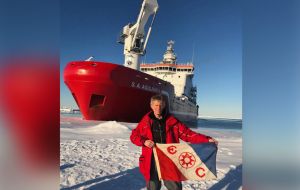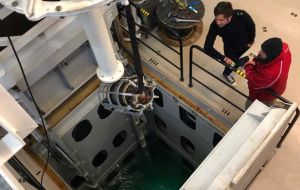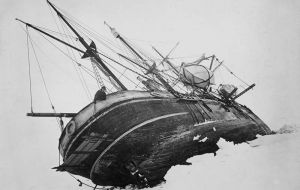MercoPress. South Atlantic News Agency
Shackleton blog: Agulhas II positioned where the Endurance went down crushed by ice
![“Good Morning from the Bridge. This is to say we have reached the Endurance sinking position. Lekker Lekker Lekker [Afrikaans for “Nice, Nice, Nice”]”](/data/cache/noticias/68582/760x480/sa-agulhas-ii-iceshelf-optim.jpg) “Good Morning from the Bridge. This is to say we have reached the Endurance sinking position. Lekker Lekker Lekker [Afrikaans for “Nice, Nice, Nice”]”
“Good Morning from the Bridge. This is to say we have reached the Endurance sinking position. Lekker Lekker Lekker [Afrikaans for “Nice, Nice, Nice”]”  Mensun Bound with the flag of the Explorer's Club of New York
Mensun Bound with the flag of the Explorer's Club of New York  The Agulhas II will have to periodically shift its hull to maintain open holes in the floes, through which to launch and recover AUVs. The ship's moon poole.
The Agulhas II will have to periodically shift its hull to maintain open holes in the floes, through which to launch and recover AUVs. The ship's moon poole.  Polar explorer Sir Ernest Shackleton and his crew had to abandon Endurance in 1915 when it was crushed by sea ice and sank in 3,000m of water
Polar explorer Sir Ernest Shackleton and his crew had to abandon Endurance in 1915 when it was crushed by sea ice and sank in 3,000m of water South African icebreaker Agulhas II, 05.24 hours GMT. Ice Pilot Freddie Ligthelm over ship’s intercom: “Good Morning from the Bridge. This is to say we have reached the Endurance sinking position. Lekker Lekker Lekker [Afrikaans for “Nice, Nice, Nice”]”
All day Saturday we were wedged in thick ice 19 miles from the site. At 00.36 hours today, 10 February 2019, we were able to break the grip of the ice and resume our passage to the Endurance search area.
At 05.24 GMT we arrived at the last position recorded by the Captain of the Endurance, Frank Worsley: Latitude 68⁰ 39’ S; Longitude 52⁰ 26’ W.
No wind, overcast, good visibility, multi-year ice , water depth 3038 meters.
A CTD probe is currently being undertaken to determine water temperature and conductivity, information that is necessary for AUV operations. The underwater search, which will be conducted by AUV 7, will begin after 12.00 hours. Its mission will take about 45 hours.
The significance of the moment was underlined by Mensun Bound, Director of Exploration: “We are the first people here since Shackleton and his men!”
By Mensun Bound (Director of Exploration)
PD. Polar explorer Sir Ernest Shackleton and his crew had to abandon Endurance in 1915 when it was crushed by sea ice and sank in 3,000m of water.
Their escape across the frozen floes on foot and in lifeboats is an extraordinary story that has resonated down through the years - and makes the wooden polar yacht perhaps the most sought-after of all undiscovered wrecks.
Operating from the South African ice-breaker, the S.A. Agulhas II, the team's plan is to put down an autonomous underwater vehicle (AUV) to map the seafloor for anomalies.
A wide box has been designated, and the robot, equipped with side-scan sonar, will run back and forth across this search zone like a lawnmower. Itsfirst dive will last 45 hours.
There will be no attempt to retrieve artifacts should the Endurance be found. The intention only is to make a 3D model of the wreck site.
The search will be challenging because of the sea ice at the surface. The Agulhas will have to periodically shift its hull to maintain open holes in the floes, through which to launch and recover AUVs.
Scientists are extremely confident they are in the right place to find Endurance.
Shackleton's skipper, Frank Worsely, was a very skilled navigator and used a sextant and chronometer to calculate the precise co-ordinates of the Endurance sinking - 68°39'30.0“ South and 52°26'30.0” West.
The ship is almost certainly within a few nautical miles of this point - and there is every chance it is in reasonable condition.
Just getting to the search site is a remarkable effort. The Agulhas has had to fight its way through ice that has thickened over several years.
Unlike Shackleton, however, the Weddell Sea Expedition team has been assisted by satellite ice charts, which make picking a way through the floes a lot easier.
The significance of the moment was not lost on the expedition's marine archaeologist, Mensun Bound: “We are the first people here since Shackleton and his men!” he was quoted as saying.




Top Comments
Disclaimer & comment rulesCommenting for this story is now closed.
If you have a Facebook account, become a fan and comment on our Facebook Page!